Abstract
Objective: This study aimed to evaluate the impact of an exclusively vegetarian diet, combined with physical activity and lifestyle interventions, on metabolic parameters in patients with metabolic syndrome, with a focus on preventing premature aging and improving overall health status. Materials and Methods: A total of 150 participants (82 females, 68 males; aged 36–80 years, with a mean age of 61.45 years) diagnosed with metabolic syndrome were enrolled. Participants followed an exclusively vegetarian diet (≈2100 kcal/day; 65% carbohydrates, 23% lipids, 15% proteins, 52.4 g dietary fiber, and 0 mg cholesterol) along with a structured lifestyle program that included physical activity (2.5 h/day, intensity 2–6 METs), psychological counseling, smoking cessation support, weight and blood pressure management, hydrotherapy, massage, phytotherapy, and stress-reduction sessions. Baseline and post-intervention assessments were performed to measure total cholesterol, LDL, HDL, triglycerides, glycemia, BMI, and blood pressure. Results: After 10 days of intervention, significant improvements were observed across all measured parameters: total cholesterol decreased by 41.21 mg/dL (−19.54%), triglycerides decreased by 72.86 mg/dL (−34.9%), LDL cholesterol decreased by 26.24 mg/dL (−19.71%), fasting glycemia decreased by 30.4 mg/dL (−21.61%), BMI decreased by 3%, systolic blood pressure decreased by 10.82 mmHg, and diastolic blood pressure decreased by 6.44 mmHg. Conclusions: Our findings demonstrate that a structured lifestyle intervention, centered on a vegetarian diet and physical activity, has a significant beneficial effect on metabolic health. This approach improves cardiovascular risk factors, glycemic control, and body composition, and may play a preventive role against premature aging.
1. Introduction
Based on their effects on metabolic function, nutritive substances are classified into five groups: proteins, carbohydrates, minerals, vitamins, and water. Each of these should represent a specific percentage of a daily diet: 11–13% protein, 55–65% carbohydrates, and 20–30% lipids. Essential nutrients that cannot be synthesized by the human body must be obtained from a balanced diet. These are represented by water, fatty acids (alpha-linolenic and linolenic acid), amino acids (leucine, isoleucine, lysine, methionine, phenylalanine, threonine, tryptophan, and valine), some minerals, and vitamins [1].
In order to achieve good nutrition, we must follow the eight principles of a healthy diet, promoted by Dr. Colin Campbell, director of the China–Oxford–Cornell Project, as mentioned in his book, “China Project” [2].
Over the past few decades, many doctors, nutritionists, and researchers have developed various diets, each with distinct goals, objectives, and outcomes. Below, we refer to the most popular and well-researched diets, published by news outlets such as Medical News Today and U.S. News [3,4]. Some well-known diets include the Atkins, Zone, Keto, vegetarian, raw vegetarian, South Beach, Weight Watchers, Mediterranean, traditional, and Western diets.
Aside from its positive effects, the vegetarian diet has multiple metabolic benefits, including an increase in butyrate in intestinal microbiota, which induces incretin secretion and improves glucose metabolism (similar to the effects of plant-based polyphenols), thereby boosting the functions of β-pancreatic cells. In contrast, saturated fats and rich meats affect β-pancreatic cells, while omega-3 fatty acids found in fish decrease insulin secretion and post-prandial GLP-1 levels. This diet has been shown to significantly improve mental health and quality of life [5,6,7,8]. These benefits are demonstrated in relatively small population groups, known for their longevity and good health conditions (Okinawa Island inhabitants, the Hunza Tribe from Central Asia, the Sherpa people from Nepal, the Otomi Indians, and the inhabitants of Vilcabamba Valley from South America) [9].
Metabolic syndrome (insulin resistance, X syndrome) represents a significant risk factor for cardiovascular diseases, type 2 diabetes, and hepatic steatosis, encompassing a broad spectrum of metabolic disorders: abdominal obesity, arterial hypertension, dyslipidemia, and endothelial dysfunction [10,11]. Its causes are complex, involving a series of interactions between genetic, metabolic, environmental, and hormonal risk factors, which ultimately result in the hallmarks of metabolic syndrome, including obesity/overweight, sedentary lifestyle, frailty, and lipodystrophy. Insulin resistance is a central factor in the development of metabolic syndrome. An intracellular excess of fatty acid metabolites contributes to changes in intracellular signaling pathways, leading to insulin resistance and the formation of triglyceride conglomerates in skeletal and heart muscles, as well as the liver, which increases hepatic glucose production. Excess adipose tissue is associated with the overproduction of proinflammatory cytokines [11,12].
According to a consensus published in 2009 by the American Heart Association and the National Heart, Lung, and Blood Institute, metabolic syndrome is diagnosed based on three or more of the five main criteria: central obesity, hypertriglyceridemia, low levels of HDL, high blood pressure, and fasting blood glucose [10,12]. Regarding its management, the following treatment scheme should be followed: bariatric surgery, lifestyle changes, and drug therapy.
Therefore, the main aim of this study was to evaluate the short-term effects of a 10-day lifestyle intervention—combining an exclusively vegetarian diet, structured physical activity, and complementary therapies—on serum lipid profile, fasting glycemia, body weight, BMI, and blood pressure in patients with metabolic syndrome, to assess its potential role in improving metabolic health and preventing premature aging.
2. Materials and Methods
Plant-based diets are recognized for their significant impact on the prevention and treatment of various diseases. The studied cohort comprised 150 patients diagnosed with metabolic syndrome who followed an exclusive vegetarian diet tailored to their individual physiological needs. The caloric intake was approximately 2100 calories/day, formulated to target:
- Normalizing cholesterol plasmatic levels, with lipids providing 23% of total daily caloric intake (5% saturated fats, 5% monounsaturated fats, 13% polyunsaturated fats, and 3,8g of linoleic acid);
- Normalizing fasting blood glucose levels, with carbohydrates providing 66% of total daily caloric intake (mostly derived from complex carbohydrates found in whole wheat bread and cereals, which provide 52.4 g of fiber);
- Normalizing uric acid serum levels, with proteins providing 12% of total daily caloric intake (only plant-based proteins) [13].
The study cohort underwent an intensive procedure that included several protective factors in addition to a vegetarian diet, a physical program, antistress and psychological counseling, support for quitting smoking, body weight control, blood pressure management, and group therapy [11]. The key aspects of this program were physical activity and diet.
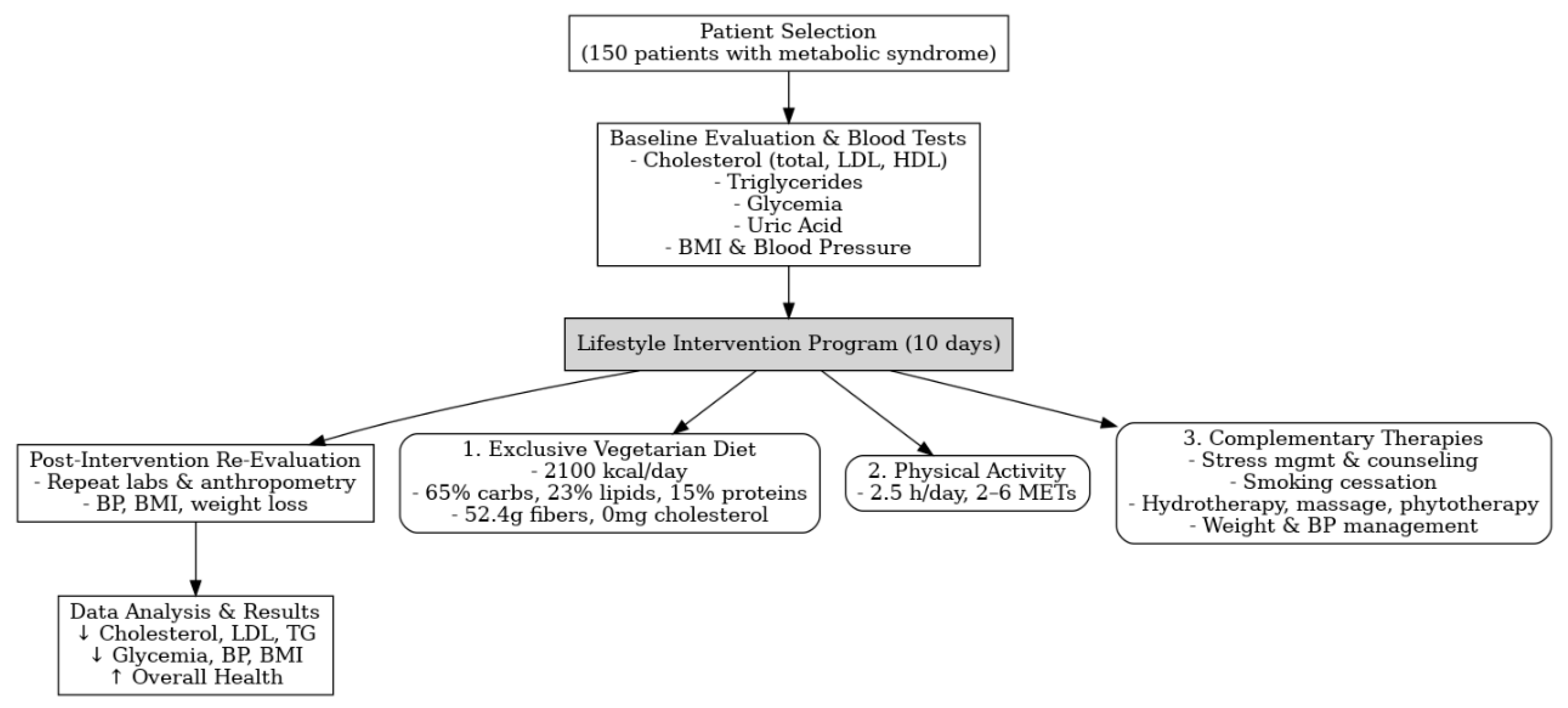
Ten-day treatment plan. All participants remained within the facility during the intervention to ensure full adherence to the program and standardized conditions.
2.1. Exclusive Vegetarian Diet
The diet was cholesterol-free and rich in vitamins (beta-carotene, folic acid, B1, B3, B6, C, E), minerals (Mg, Fe, K, Se), and phytochemicals. It was created based on the vegetarian diet pyramid, as elaborated by Dr. Ella Haddad from the University of Medicine of Loma Linda (2008 version) (Figure 1) [13].
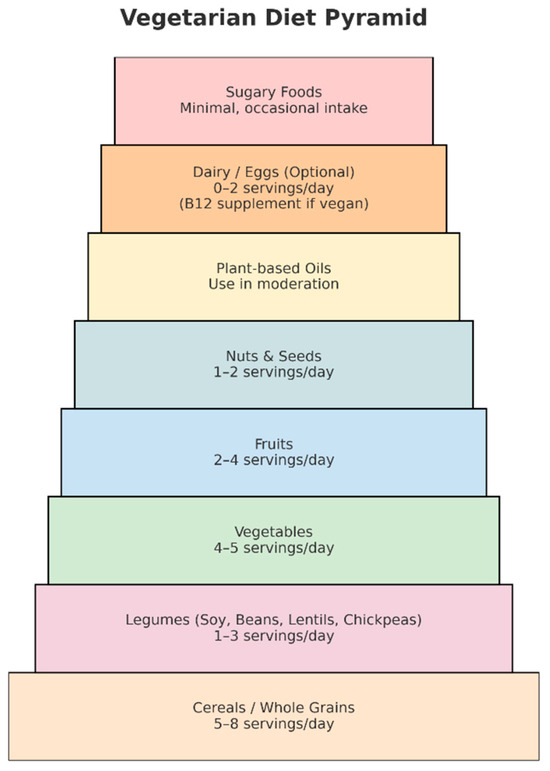
Figure 1.
Vegetarian diet pyramid showing the recommended daily servings of major food groups included in the 10-day lifestyle intervention program.
- Cereals/Whole-grains: 5–8 servings/day (e.g., whole wheat bread, oats, brown rice);
- Vegetables: 4–5 servings/day, emphasizing variety and color;
- Fruits: 2–4 servings/day;
- Legumes (soy, beans, lentils, chickpeas): 1–3 servings/day;
- Nuts and Seeds: 1–2 servings/day (unsalted, unroasted);
- Plant-Based Oils: Used in moderation, preferably cold-pressed;
- Dairy/Eggs (Optional): 0–2 servings/day; for vegan diets, ensure vitamin B12 supplementation;
- Sugary Foods: Occasional consumption, minimal amounts.
The vegetarian diet pyramid includes the main food groups: those at the top are necessary in small quantities, while at the base, the most important foods, such as those for nutritional intake, are necessary in larger amounts [13]. As a result, in designing the daily menu, we considered these nutritional groups, but with fewer portions from each category.
Additionally, the following principles were respected in planning the menu:
- (1)
- The quality principle:
- Choose foods from the above list (Figure 1);
- Avoid refined or fiber-lacking foods;
- Fiber-rich foods include whole-grain cereals, vegetables, and fruits;
- Foods with lower amounts of fiber include refined foods, such as white flour, sugar, and products made from meat, milk, and eggs.
- (2)
- The quantity principle:
- Breakfast represents the most important meal of the day, and it should be composed of whole-grain cereals, nuts, milk, and fruits;
- Lunch is also an important meal, as it needs to satisfy the body’s nutrient needs for the rest of the day. It should include a product rich in protein;
- Dinner should be the lightest meal of the day, composed mainly of fruits. It is recommended that elderly individuals and those who are sedentary should abstain from it.
- (3)
- Time principle:
- Adhere to an organized and regular food schedule, ensuring the last meal is had by 19:00 at the latest;
- Maintain a 5–6 h interval between meals, prohibiting snacks;
- Allocate at least 30 min for each meal.
- (4)
- Diversity principle:
- Daily food selection should be varied;
- Eat a maximum of 2–3 types of dishes at each meal.
- (5)
- The cooking principle:
- Keep the natural taste of food and avoid salt and irritant spices (pepper, chili) in excess;
- Avoid frying and boiling; steam or bake the food;
- Reduce consumption of high-sodium foods, such as pickles, cheese, and canned foods.
2.2. Each Patient’s Menu Included
- (1)
- Breakfast: 40–50% of total daily calorie intake
- Boiled cereals (oat flakes, wheat, and groats), granola, muesli, and cornflakes;
- Whole-grain bread;
- Fruits: apples, pears, bananas, apricots, citrus, forest fruits, and other seasonal fruits;
- Spreadable creams, fruit jam, peanut butter, avocado, and soy pate;
- Nuts or seeds;
- Soy/rice/coconut/almond/sesame milk [13].
- (2)
- Lunch
- Main dish: meat/veggie balls, veggie burgers, vegetables, nutty and seed derivatives;
- Side dishes made from raw or boiled vegetables;
- Raw salads, fish with dressings or salads;
- Whole-grain bread;
- Desserts [13].
- (3)
- Evening Dinner
- Soups or salads;
- Fruits, fruit crisps, and fruit salads;
- Smoothies;
- Whole-grain bread, biscuits, whole-grain cereals, and popcorn [13].
Patients who wanted to lose weight (to balance their metabolic disorders in situations like type 2 diabetes) could have tea at 6 o’clock.
Table 1provide an example of a specific 2000-kilocalorie/day menu that was consumed for 11 days.

Table 1.
An example of a 2000-kilocalorie/day menu that was consumed for 11 days.
- a. Physical Activity (Kinesiotherapy)
Physical activity, the second key element of the program, included any movements produced by muscular–skeletal activity that led to a substantial increase in energy production above resting levels. There are over 640 muscles in the human body, which represent 30–45% of total body weight, consuming approximately 25% of the energy used while at rest. It is known that moderate physical activity, such as running, power walking, and swimming, regularly practiced for at least 30 min per day, lowers blood pressure by approximately 4–9 mmHg [14]. The most important outcomes to consider are decreased insulin secretion before meals and increased insulin sensitivity, which reduces cardiovascular risk factors and promotes weight loss [15].
Our study cohort participated in a 2.5-h physical activity program with intensities ranging from 2 to 6 METs, tailored to their individual chronic disease status.
- b. Patient Educational Workshops: Health, Nutrition, and Healthy Cooking Classes
- c. Other Therapies
- -
- Hydrotherapy [15];
- -
- Swedish massage for relaxation and posture (50 min);
- -
- Clay and paraffin packing;
- -
- Charcoal and plant patches;
- -
- Phytotherapy;
- -
- Psychological counseling.
- d. Blood Test Parameters
- -
- Total cholesterol optimal value: <200 mg/dL;
- -
- HDL cholesterol optimal value: ≥50 mg/dL (females) and ≥ 40 mg/dL (males);
- -
- LDL cholesterol optimal value: <100 mg/dL;
- -
- Serum triglycerides levels: <150 mg/dL;
- -
- Fasting blood glucose level between 65 and 110 mg/dL;
- -
- Based on BMI value, patients can be classified as:
- *
- Underweight: <18.5 kg/m2;
- *
- Normal range: 18.5–24.9 kg/m2;
- *
- Overweight: 25–29.9 kg/m2;
- *
- Obese: ≥30 kg/m2.
- -
- Other routinely investigated parameters included uric acid, urea, creatinine, atherogenic coefficient, calcium, and magnesium.
- e. Blood Pressure Monitoring
Blood pressure in healthy adults is classified as follows:
- -
- Ideal blood pressure: 110/60 mmHg;
- -
- Optimal blood pressure: <120/80 mmHg;
- -
- Normal blood pressure: <130/85 mmHg;
- -
- Borderline blood pressure: <140/90 mmHg;
Patients with a value of 140/90mmHg or higher are diagnosed with arterial hypertension, which can be classified into class I, class II: mild, and class III: severe [14].
- f. Patient Index
In total, 150 patients were involved in our study (82 females and 68 males), ranging from 36 to 80 years old, with an average age of 61.45 years old:
- *
- Between 35 and 45 years old: 7 patients;
- *
- Between 46 and 55 years old: 31 patients;
- *
- Between 56 and 65 years old: 65 patients;
- *
- Between 66 and 75 years old: 36 patients;
- *
- Over 75 years old: 11 patients.
- g. Blood Tests
We analyzed venous blood samples to evaluate metabolism and different parameters.
Describing dietary intervention: Table 1 present the list of food options available for each meal category during the 10-day vegetarian intervention program. Participants could choose freely among the listed dishes/foods within each meal category (breakfast, lunch, and dinner) to achieve the target energy and macronutrient distribution for the day, as guided by the nutritionist supervising the program. The tables are not prescriptive single-meal menus but rather a selection of standardized options from which individualized meals were composed.
Participants were provided with a fully plant-based menu prepared under the supervision of a certified nutritionist. Meals were served three times per day (breakfast, lunch, and dinner) with two optional snacks. Individual energy needs were calculated based on age, sex, weight, and activity level, in accordance with the WHO/FAO recommendations. Daily food intake was monitored by direct observation and food records. The nutrition staff ensured that each participant consumed the entire portion served, and any leftovers were accurately recorded.
- Anthropometric Measurements
Body weight was measured to the nearest 0.1 kg using a calibrated digital scale (SECA®, SECA GmbH& Co.KG, Hamburg, Germany), with participants wearing light clothing and no shoes. Height was measured at baseline using a stadiometer and used to calculate BMI (kg/m2).
- Blood Pressure Measurement
Systolic and diastolic blood pressure were measured using an automated sphygmomanometer (Omron® HEM series, Omron Corporation, Shimogyo-ku, Kyoto, Japan) in a seated position, after 5 min of rest. Measurements were taken twice daily (morning and evening), and the mean value was recorded.
- Biochemical Analysis
Venous blood samples were collected at baseline (day 0) and at the end of the intervention (day 10) after an overnight fast of at least 10 h. Serum total cholesterol, LDL cholesterol, HDL cholesterol, triglycerides, and fasting blood glucose were analyzed using an automated chemistry analyzer in the certified laboratory. Quality control procedures were implemented in accordance with international standards.
- Inclusion and Exclusion Criteria for the Participants
Participants were recruited from outpatient clinics and hospital referrals.
Inclusion criteria:
- Adults aged 35–80 years;
- Diagnosis of metabolic syndrome according to the criteria of the American Heart Association/National Heart, Lung, and Blood Institute (≥3 of 5: central obesity, hypertriglyceridemia, low HDL, high blood pressure, fasting hyperglycemia);
- Willingness to adhere to a 10-day lifestyle program including diet, physical activity, and counseling;
- Written informed consent was obtained before participation.
- Exclusion Criteria
- Severe cardiovascular, renal, or hepatic failure;
- Active malignancy or acute infection;
- Psychiatric disorders preventing participation in group activities;
- Use of lipid-lowering or weight loss medications initiated within 3 months prior to the study;
- Pregnancy or lactation.
- Participant Characteristics
A total of 150 participants were included (82 females and 68 males), with an average age of 61.45 years. Age distribution was as follows: 7 participants aged 35–45 years, 31 participants aged 46–55 years, 65 participants aged 56–65 years, 36 participants aged 66–75 years, and 11 participants aged > 75 years. Participants were clinically stable at baseline and had no contraindications to moderate physical activity.
2.3. Statistical Analysis
All data collected in this study were expressed as mean ± standard deviation (SD). Statistical analysis was performed using IBM SPSS Statistics for Windows, Version 26.0 (IBM Corp., Armonk, NY, USA).
Comparisons between baseline (admission) and post-intervention (end of program) values were carried out using paired Student’s t-test for normally distributed variables and Wilcoxon signed-rank test for variables with non-normal distribution. Categorical variables were analyzed using the Chi-square (χ2) test.
A p-value < 0.05 was considered statistically significant. All bar charts (Figure 2, Figure 3, Figure 4, Figure 5, Figure 6, Figure 7, Figure 8, Figure 9, Figure 10, Figure 11, Figure 12, Figure 13, Figure 14, Figure 15, Figure 16, Figure 17, Figure 18 and Figure 19) represent mean values with standard deviation bars, and each figure indicates statistical significance (* p < 0.05, * p < 0.01, ns = not significant) where applicable.
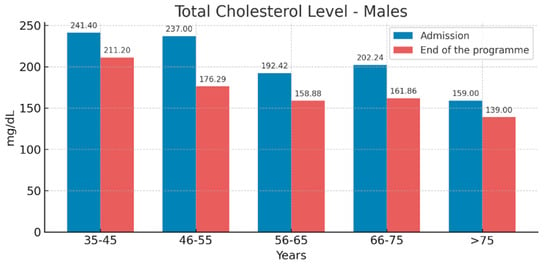
Figure 2.
Total cholesterol levels in males at baseline (admission) and after 10 days of the lifestyle program. Data are presented as mean ± standard deviation (SD). TC = Total cholesterol (mg/dL). p < 0.05 compared with baseline (paired t-test).

Figure 3.
Total cholesterol levels in females at baseline (admission) and after 10 days of the lifestyle program. Data are presented as mean ± SD. TC = Total cholesterol (mg/dL). p < 0.05 compared with baseline (paired t-test).
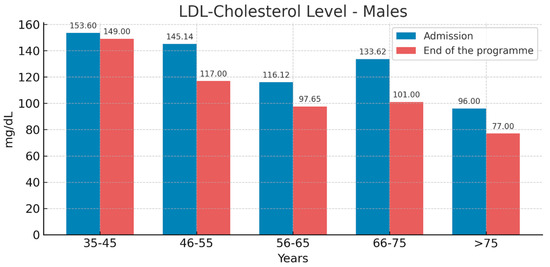
Figure 4.
LDL cholesterol levels in males at baseline and after 10 days of the program. Data are presented as mean ± SD. LDL = Low-density lipoprotein cholesterol (mg/dL). p < 0.05 compared with baseline (paired t-test).
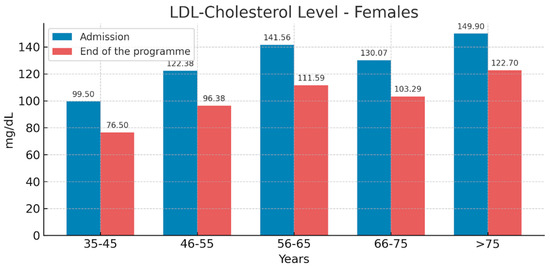
Figure 5.
LDL cholesterol levels in females at baseline and after 10 days of the program. Data are presented as mean ± SD. LDL = Low-density lipoprotein cholesterol (mg/dL). p < 0.05 compared with baseline (paired t-test).
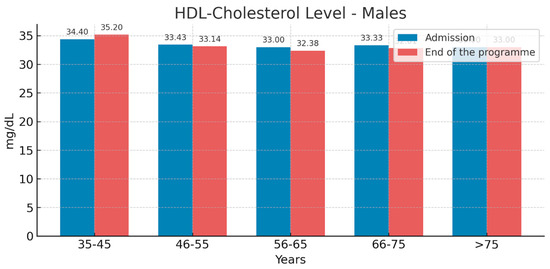
Figure 6.
HDL cholesterol levels in males at baseline and after 10 days of the program. Data are presented as mean ± SD. HDL = High-density lipoprotein cholesterol (mg/dL). p < 0.05 compared with baseline (paired t-test).
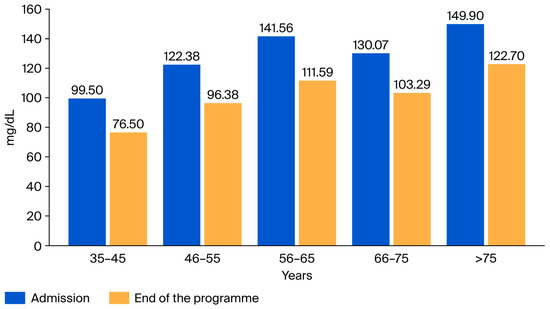
Figure 7.
HDL cholesterol levels in females at baseline and after 10 days of the program. Data are presented as mean ± SD. HDL = High-density lipoprotein cholesterol (mg/dL). p < 0.05 compared with baseline (paired t-test).
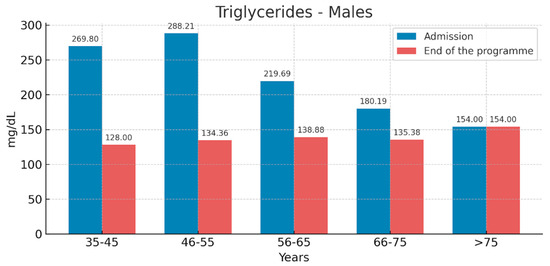
Figure 8.
Serum triglyceride levels in males at baseline and after 10 days of the program. Data are presented as mean ± SD. TG = Triglycerides (mg/dL). p < 0.05 compared with baseline (paired t-test).
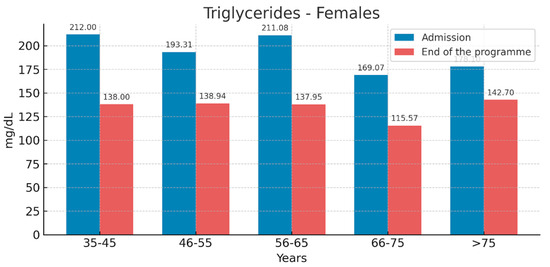
Figure 9.
Serum triglyceride levels in females at baseline and after 10 days of the program. Data are presented as mean ± SD. TG = Triglycerides (mg/dL). p < 0.05 compared with baseline (paired t-test).
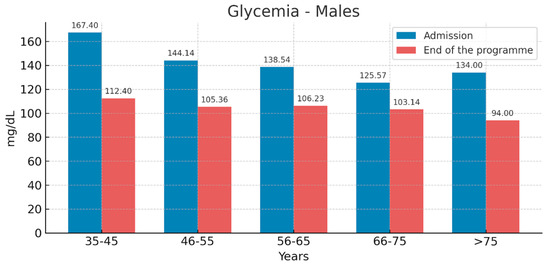
Figure 10.
Fasting glycemia levels in males at baseline and after 10 days of the program. Data are presented as mean ± SD. FBG = Fasting blood glucose (mg/dL). p < 0.05 compared with baseline (paired t-test).
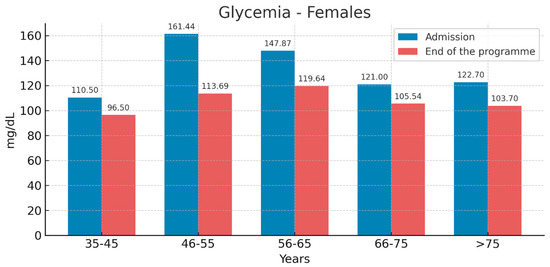
Figure 11.
Fasting glycemia levels in females at baseline and after 10 days of the program. Data are presented as mean ± SD. FBG = Fasting blood glucose (mg/dL). p < 0.05 compared with baseline (paired t-test).
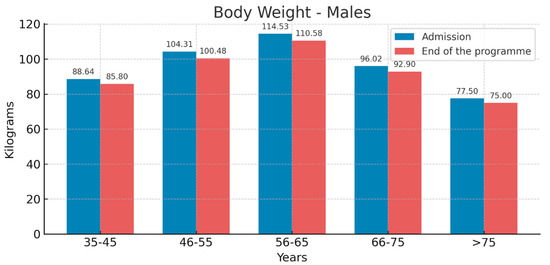
Figure 12.
Body weight in males at baseline and after 10 days of the program. Data are presented as mean ± SD. BW = Body weight (kg). p < 0.05 compared with baseline (paired t-test).
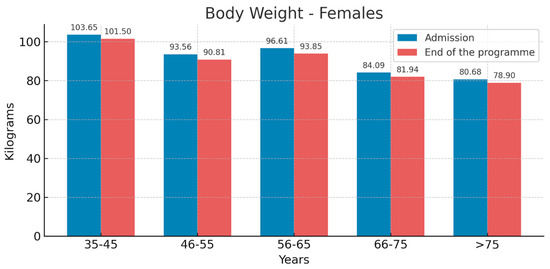
Figure 13.
Body weight in females at baseline and after 10 days of the program. Data are presented as mean ± SD. BW = Body weight (kg). p < 0.05 compared with baseline (paired t-test).
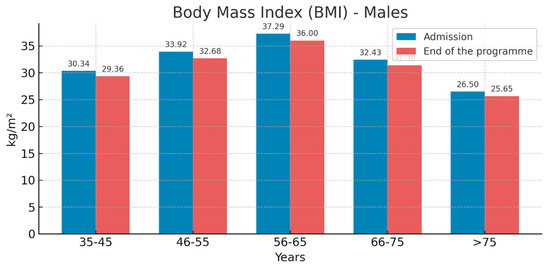
Figure 14.
Body mass index (BMI) in males at baseline and after 10 days of the program. Data are presented as mean ± SD. BMI = Body mass index (kg/m2). p < 0.05 compared with baseline (paired t-test).
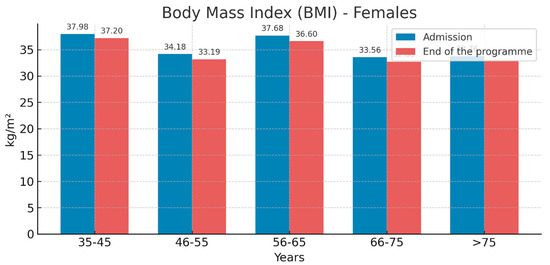
Figure 15.
Body mass index (BMI) in females at baseline and after 10 days of the program. Data are presented as mean ± SD. BMI = Body mass index (kg/m2). p < 0.05 compared with baseline (paired t-test).
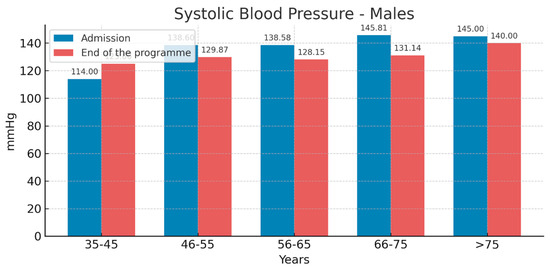
Figure 16.
Systolic blood pressure in males at baseline and after 10 days of the program. Data are presented as mean ± SD. SBP = Systolic blood pressure (mmHg). p < 0.05 compared with baseline (paired t-test).
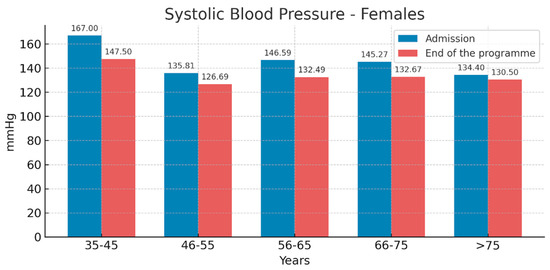
Figure 17.
Systolic blood pressure in females at baseline and after 10 days of the program. Data are presented as mean ± SD. SBP = Systolic blood pressure (mmHg). p < 0.05 compared with baseline (paired t-test).
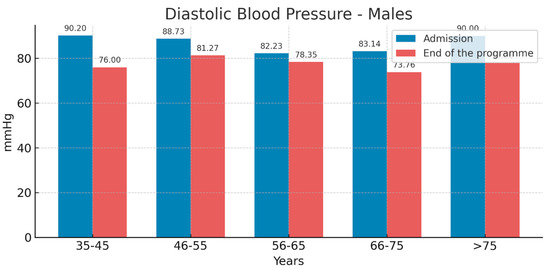
Figure 18.
Diastolic blood pressure in males at baseline and after 10 days of the program. Data are presented as mean ± SD. DBP = Diastolic blood pressure (mmHg). p < 0.05 compared with baseline (paired t-test).
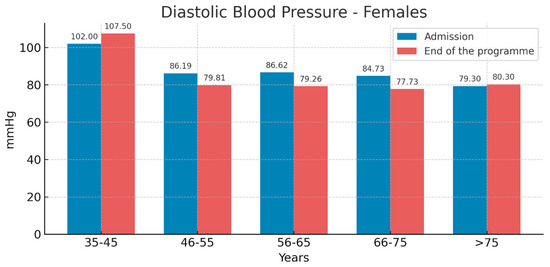
Figure 19.
Diastolic blood pressure in females at baseline and after 10 days of the program. Data are presented as mean ± SD. DBP = Diastolic blood pressure (mmHg). p < 0.05 compared with baseline (paired t-test).
3. Results
The patients in our study consumed a 100% vegetarian diet with a daily caloric intake of 2100 calories, 65% mostly complex carbohydrates, 52.4g of fiber, ≤23% fats with a 2.24/1 ratio of polyunsaturated and saturated fats, 3.8 mg of essential linolenic acid, 0 mg of cholesterol, and 15% protein. This diet was planned according to the guidelines issued by the Academy of Nutrition and Dietetics, the American Diabetes Association, and the Medical Institute of the American Academy of Science, which recommend distributing the energy intake from various sources: 45–65% from carbohydrates, 20–35% from lipids, and 10–35% from protein [16].
The first graphic (Scheme 1) shows the overall calorie consumption, as well as the calories from sugar, fats, and proteins, at different times of the day. Notably, there was a higher calorie intake during breakfast and lunch, and a gastro-protective and hypocaloric dinner.
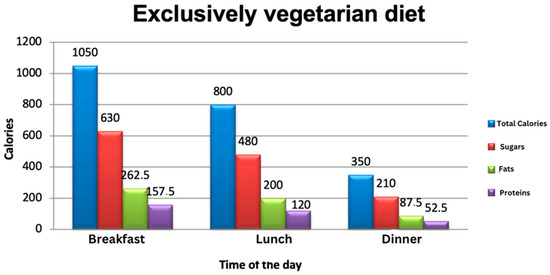
Scheme 1.
Total calorie intake of our study cohort, the result of our study.
A comparative analysis of blood test parameters before and after 10 days of lifestyle changes is shown in Figure 2, Figure 3, Figure 4, Figure 5, Figure 6, Figure 7, Figure 8, Figure 9, Figure 10, Figure 11, Figure 12, Figure 13, Figure 14, Figure 15 and Figure 16. The results are statistically significant.
Our findings show the following:
- Serum cholesterol levels:
Of the 150 patients, 83 had cholesterol levels over 200 mg/dL on admission, and after 10 days, only 29 patients still had values higher than normal.
On average, in males, cholesterol levels decreased by 36.98 mg/dL, with the best results observed in patients aged between 46 and 55 years, where the average value decreased by 60.71 mg/dL following this program (Figure 2).
In the female group, cholesterol levels decreased on average by 39.07 mg/dL, but the most significant results were observed in the age group between 56 and 65 years, in which the average value decreased by 45.07 mg/dL (Figure 3).
- LDL cholesterol:
Of the 150 patients, 114 had LDL-cholesterol values over 100 mg/dL upon admission, compared with only 72 patients who had higher LDL cholesterol levels after 10 days. In males, LDL levels decreased on average by 20.57 mg/dL, but the best results were observed in males aged between 66 and 75 years, in which the average value decreased by 32.62 mg/dL (Figure 4).
In females, LDL levels decreased on average by 26.65 mg/dL, but the best results were observed in females aged between 56 and 65 years, in which the average value decreased by 29.97 mg/dL (Figure 5).
- HDL Cholesterol:
On the first day of admission, 60 males had HDL levels below 40 mg/dL, and 70 females had HDL levels below 50 mg/dL. After the 10-day program, the best results were observed in patients aged between 35 and 45 years, in whom HDL levels increased on average by 0.8 (Figure 6) in males and by 5 mg/dL in females (Figure 7).
- Serum triglycerides
On the first day of admission, 108 patients had serum triglyceride levels above 150 mg/dL, while at the end of the program, only 42 patients, less than a third, had serum triglyceride levels within normal range. In males, serum triglyceride levels decreased on average by 84.26 mg/dL, but the best results were observed in males aged between 46 and 55 years, in whom the average value decreased by 153.85 mg/dL (53.38%) after the program (Figure 8).
In females, serum triglyceride levels decreased on average by 57.03 mg/dL, but the best results were observed in females aged between 35 and 45 years, in whom the average value decreased by 74 mg/dL after the program (Figure 9).
- Glycemia
Fasting glycemia levels measured on admission were over 110 mg/dL in 125 patients, while after the program, their levels decreased to 82 mg/dL.
In males, glycemia levels decreased on average by 37.7 mg/dL, but the best results were observed in males aged between 35 and 45 years old, in whom the average value decreased by 55 mg/dL (32%) after 10 days of treatment (Figure 10).
In females, glycemia levels decreased on average by 25.5 mg/dL, but the best results were observed in females aged between 46 and 55 years, in whom the average value decreased by 47.75 mg/dL (29%) after the 10-day program (Figure 11).
- Body weight
We followed the evolution of fat percentage in correlation with body weight in our 150 patients, from which males managed to lose on average 3.25 kg, more than females, who lost only 2.33 kg on average. The best results were observed in individuals aged 56–65 years, where the average weight loss was 3.95 kg in males and 2.76 kg in females (Figure 12 and Figure 13).
- Body mass index (BMI)
On the first day of admission, 119 patients registered a BMI of 30 kg/m2, while at the end of the program, only eight patients managed to lower their BMI. The best results were observed in individuals aged 56–65 years, where the average BMI decreased by 1.29 kg/m2 in males and by 1.08 kg/m2 in females (Figure 14 and Figure 15).
- Systolic and diastolic blood pressure
Of the 150 patients involved in this study, 99 had a systolic blood pressure of over 130 mmHg on admission, while 69 had a diastolic blood pressure of over 85 mmHg.
After 10 days of lifestyle changes, systolic blood pressure decreased by 5.57 mmHg in males, while in females, systolic blood pressure decreased by an average of 11.84 mmHg, which is twice that in males. The best results were observed in males aged between 66 and 75 years, in whom systolic blood pressure decreased by 14.67 mmHg (Figure 16), and in females aged 35–45 years, of whom systolic blood pressure decreased by 19.5 mmHg (Figure 17).
After 10 days of lifestyle changes, diastolic blood pressure decreased on average by 9.39 mmHg in males, while females registered a slight decrease, averaging 2.85 mmHg. The best results were observed in males aged between 35 and 45 years, whose diastolic blood pressure decreased by 14.2 mmHg (with 15% from the initial measurement) (Figure 18), and in females aged between 56 and 65 years, whose diastolic blood pressure decreased by 7.36 mmHg (Figure 19).
4. Discussion
This study demonstrates that a short-term, intensive lifestyle intervention combining an exclusively vegetarian diet with physical activity, psychological counseling, and supportive therapies produced significant improvements in metabolic health in patients with metabolic syndrome.
Our findings align with previous studies, which have shown that plant-based diets are associated with lower total cholesterol, LDL cholesterol, and triglyceride levels, as well as improved glycemic control [17]. The magnitude of lipid reduction observed in our study (−19.5% total cholesterol) is clinically relevant and comparable to the effect of moderate-dose statin therapy reported in randomized clinical trials [18].
Improvements in blood pressure and BMI further support the potential of lifestyle modification as a first-line approach for managing metabolic syndrome. Reductions in systolic blood pressure of >10 mmHg have been shown to lower the risk of cardiovascular events by up to 20% [19].
Interestingly, the increase in HDL cholesterol levels was modest and not statistically significant, which is consistent with other studies indicating that dietary interventions have less impact on HDL levels compared to LDL levels [20].
The short duration of the intervention is a limitation, as long-term sustainability of the results was not assessed. However, the rapid metabolic response suggests that even short-term dietary and lifestyle changes can yield measurable health benefits. Future studies with longer follow-up are warranted to confirm the persistence of these effects.
Overall, this study supports the integration of structured lifestyle programs into routine care for patients with metabolic syndrome as an effective, non-pharmacological approach to reduce cardiometabolic risk and promote healthy aging.
A key finding of this study is the high dietary fiber intake observed in participants (mean 52.4 g/day), which substantially exceeds the recommended dietary allowance (RDA) of 25–38 g/day for adults. This elevated fiber consumption likely contributed to the improvements in fasting glycemia and serum lipid profile observed in this cohort, consistent with previous studies that demonstrate soluble and insoluble fiber enhances insulin sensitivity, promotes satiety, and reduces cholesterol absorption [21,22].
However, excessive fiber intake (>50–60 g/day) may be associated with gastrointestinal symptoms such as bloating, abdominal cramping, diarrhea, or constipation. Although no clinically significant adverse events were reported during the 10-day intervention, careful monitoring is recommended in long-term interventions. Additionally, high-fiber diets may reduce the bioavailability of minerals such as iron, zinc, calcium, and magnesium [23]. While our program was nutritionally supervised and designed to meet recommended micronutrient intakes, these potential limitations should be considered, particularly for participants who adhere to strict vegan diets without access to fortified foods or supplements.
Future studies should evaluate both gastrointestinal tolerance and micronutrient status (e.g., serum ferritin, zinc, and vitamin B12) to ensure the safety and nutritional adequacy of high-fiber vegetarian interventions over prolonged periods.
Our observed reduction in total cholesterol (−19.5%) and LDL cholesterol (−19.7%) is comparable to that reported by Barnard et al. [24], who found a 22% reduction in LDL levels after three weeks of a low-fat, plant-based diet combined with exercise. Similarly, reported rapid improvements in lipid profiles within two weeks using a “portfolio diet” rich in viscous fiber, soy protein, and nuts.
The decrease in triglyceride levels (−34.9%) observed in our participants aligns with the findings of Toumpanakis et al. [7], who documented substantial reductions in TG levels after four weeks of a vegan diet. Improvements in glycemic control (−21.6%) are also consistent with Kahleova et al.’s study 2019 [17], who showed that a plant-based diet enhanced insulin sensitivity and reduced HbA1c within 16 weeks.
Reductions in body weight, BMI, and blood pressure in our cohort confirm earlier findings from the Adventist Health Study 2 and the DASH trial, which demonstrated the benefits of plant-rich diets and lifestyle interventions in lowering cardiometabolic risk factors [25,26].
Taken together, these results support the evidence that lifestyle interventions can rapidly improve metabolic health and may serve as a first-line approach for patients with metabolic syndrome. Longer-term studies are needed to evaluate the sustainability of these benefits and to identify which components of the program contribute most strongly to risk reduction.
The relatively short duration of the intervention (10 days) reflects the design of the standardized lifestyle program implemented, which is intended as an intensive, structured introduction to healthier habits rather than a long-term diet plan. Despite the brief timeframe, significant improvements were observed in total cholesterol, LDL, triglycerides, fasting glycemia, BMI, and blood pressure, confirming previous evidence that the metabolic benefits of dietary and lifestyle changes can occur rapidly [24,27].
While the results are encouraging, they should be interpreted as short-term effects. Longer follow-up studies are warranted to evaluate the sustainability of these benefits and to determine the relative contribution of each intervention component (diet, physical activity, stress management).
4.1. Strengths and Limitations of This Study
4.1.1. Strengths
- Well-defined study population of 150 participants diagnosed with metabolic syndrome, with detailed baseline characterization (age, sex distribution, and clinical status).
- Standardized 10-day lifestyle intervention including a vegetarian diet, physical activity, stress management, and complementary therapies.
- Objective and reproducible biochemical and anthropometric measurements performed at baseline and post-intervention.
- Statistically robust analysis using paired tests, ensuring reliable comparisons.
- Inclusion of both sexes and multiple age groups, allowing subgroup analyses and generalizability.
4.1.2. Limitations
- A short intervention period (10 days) does not allow assessment of the long-term sustainability of improvements.
- Lack of a parallel control group limits the ability to exclude placebo or Hawthorne effects.
- Self-reported adherence to lifestyle interventions (such as diet and exercise) may introduce reporting bias.
- Results may not be generalizable to populations with severe comorbidities or different dietary patterns.
- HDL cholesterol changes were not statistically significant, and clinical relevance should be interpreted with caution.
5. Conclusions
This study was conducted on a group of 150 patients, all of whom were diagnosed with metabolic syndrome.
- A total of 68 males and 82 females;
- Age range between 36 and 80 years.
After 10 days of treatment, the following results were observed:
- Total serum cholesterol decreased on average by 41.21 mg/dL, with 19.54% less than the value registered on admission;
- Serum triglycerides decreased on average by 72.86 mg/dL, with 34.9% less than the value registered on admission;
- LDL cholesterol decreased on average by 26.24 mg/dl, with 19.71% less than the value registered on admission;
- Glycemia decreased on average by 30.4 mg/dL, with 21.61% less than the value registered on admission;
- Body weight decreased on average by 2.99 kg, resulting in a 3% BMI reduction from the initial value registered on admission;
- Systolic blood pressure decreased on average by 10.82 mmHg, but the diastolic blood pressure decreased by 6.44 mmHg, meaning a 7.6% reduction in blood pressure from the initial value registered on admission.
A 10-day intensive lifestyle intervention combining an exclusively vegetarian diet, physical activity, and complementary therapies produced significant short-term improvements in lipid profile, glycemia, BMI, and blood pressure in patients with metabolic syndrome. These findings suggest that even short-term, structured programs can rapidly improve cardiometabolic health and may serve as an effective non-pharmacological strategy for preventing and managing metabolic syndrome. Further studies are needed to confirm the long-term sustainability of these benefits.
There is increasing scientific interest in the factors that contribute to healthy longevity and extended lifespan in certain populations and regions worldwide [28]. Among the many determinants of aging, environmental exposures and dietary patterns have been shown to exert a major influence on health span and the onset of age-related diseases [28]. Diet, in particular, represents a modifiable risk factor that can either accelerate or mitigate the biological aging process. Understanding how different dietary patterns influence aging trajectories and age-related diseases can inform the development of personalized nutritional recommendations and lifestyle interventions designed to promote healthy aging and reduce morbidity [28].
Recent evidence highlights the growing global popularity of vegetarian diets, although their precise impact on healthy aging in older adults remains to be clarified [29]. Some studies suggest that the limited inclusion of nutrient-dense, animal-derived foods may improve overall health outcomes in older individuals [29]. Moreover, adherence to vegan dietary patterns has been associated with decelerated epigenetic aging, underscoring the need for additional well-designed studies to further elucidate the mechanistic links between diet and biological aging [30]. Large, prospective cohort studies and randomized clinical trials remain essential to confirm these findings and translate them into actionable dietary guidelines for healthy aging [30].
Author Contributions
Corresponding authors: O.C.B.M. and R.F. Conceptualization: O.C.B.M.; Data curation, G.P.S.; investigation: G.C.V., M.C.S., and R.F.; methodology: D.G.; software: C.I.B.; writing—original draft: M.A.U. All authors have read and agreed to the published version of the manuscript.
Funding
This research received no external funding.
Institutional Review Board Statement
This study was conducted in accordance with the ethical principles outlined in the Declaration of Helsinki. Ethical clearance was obtained from the Institutional Review Board of “Victor Babeș” University of Medicine and Pharmacy, Center for Studies in Preventive Medicine, Timișoara, Romania. Approval details: Approval Number: 1. Approval Date: 7 April 2021.
Informed Consent Statement
The objectives, potential benefits, and risks of the study were explained to all participants prior to data collection. Written informed consent was obtained from each participant. Confidentiality of all personal data was ensured, and the collected information was used solely for the purposes of this study.
Data Availability Statement
Data are contained within the article.
Conflicts of Interest
The authors declare no conflict of interest.
References
- Mănescu, S.; Bedo, C.; Dumitrache, S. Tratat De Igienă, Vol.II; Editura Medical: Bucharest, Romania, 1985. [Google Scholar]
- Campbell, T.C.; Campbell, T.M. Campbell II: The China Study. In The Most Comprehensive Study of Nutrition ever Conducted and the Startling Implication for Diet, Weight Loos and Long-Term Health; BenBellaBooks: Dallas, TX, USA, 2004. [Google Scholar]
- Christian Nordqvist. Nine Most Popular Diets Rated by Experts 2017. Available online: https://health.usnews.com/best-diet/search (accessed on 17 July 2017).
- Search Best Diets for Weight-Loss, Heart Health and More. U.S. News. Available online: https://health.usnews.com/wellness/best-diet/search (accessed on 5 April 2021).
- Kahleova, H.; Tura, A.; Hill, M.; Holubkov, R.; Barnard, N.D. A plant-based dietary intervention improves beta-cell function and insulin resistance in overweight adults. A 16-week randomized clinical trial. Nutrients 2018, 10, 189. [Google Scholar] [CrossRef]
- Chiu, T.H.T.; Pan, W.H.; Lin, M.N.; Lin, C.L. Vegetarian diet, change in dietary patterns, and diabetes risk: A prospective study. Nutr. Diabetes 2018, 8, 12. [Google Scholar] [CrossRef]
- Toumpanakis, A.; Turnbull, T.; Alba-Barba, I. Effectiveness of plant-based diets in promoting well-being in the management of type 2 diabetes: A systematic review. BMJ Open Diabetes Res. Care 2018, 6, e000534. [Google Scholar] [CrossRef] [PubMed]
- Kyrø, C.; Tjønneland, A.; Overvad, K.; Olsen, A.; Landberg, R. Higher whole-grain intake is associated with lower risk of type 2 diabetes among middle-aged men and women: The Danish Diet, Cancer, and Health Cohort. J. Nutr. 2018, 148, 1434–1444. [Google Scholar] [CrossRef]
- Claudius, M.P. Tratat Pentru Alimentatia Naturala a Omului; Editura Christalin: Bucharest, Romania, 2003; Volume 317–333, pp. 681–689. [Google Scholar]
- AMBOSS GmbH. Obesity and Metabolic Syndrome. Available online: https://next.amboss.co.m/us/article/4g03v2?q=metabolic+syndrome#Zc3983f79b8ec111f417e09fb2b300f00 (accessed on 14 March 2021).
- Dan, L. Longo, Fauci, Kasper, Hauser, Jameson, Loscaldo. Harrison Manual de Medicină, Ediţia a 18-a; Editura ALL: Bucureşti, Romania, 2014. [Google Scholar]
- Timar, R.; Vlad, A.; Sima, A. Noţiuni de Diabet, Nutriţie Şi Boli Metabolice; Editura Eurobit: Timişoara, Romania, 2014; Volume 5, pp. 23, 163–173. [Google Scholar]
- Dan, V.; Dan, N. Cartea de Bucate a Centrului Lifestyle Herghelia, Ediţia a 7-a; Viaţă şi Sănătate: Pantelimon, Romania, 2016; pp. 22, 27, 32, 34, 39–44, 57–58, 66–69, 72–79, 123–385. [Google Scholar]
- Stoica, V.; Scripcariu, V. Compendiu de Specialităţi Medico-Chirurgicale Vol.I, Ediţie revizuită-Bucureşti; Editura Medicală: Bucharest, Romania, 2018; Volume 158, p. 163. [Google Scholar]
- Ramon, C. Gelabert: Diabetul: Tratamente Ştiinţifice şi Naturale; Viaţă şi sănătate: Pantelimon, Romania, 2013; pp. 64, 106–116. [Google Scholar]
- Trumbo, P.; Schlicker, S.; Yates, A.A.; Poos, M. Dietary reference intakes for energy, carbohdrate, fiber, fat, fatty acids, cholesterol, protein and amino acids, American Dietetic Association. J. Am. Diet. Assoc. 2002, 102, 1621–1631. Available online: https://search.proquest.com/openview/41e1233015fb62ff54f496de51364921/1?pq-origsite=gscholar&cbl=49142 (accessed on 10 May 2021). [CrossRef]
- Alwarith, J.; Kahleova, H.; Rembert, E.; Yonas, W.; Dort, S.; Calcagno, M.; Burgess, N.; Crosby, L.; Barnard, N.D. Nutrition Interventions in Rheumatoid Arthritis: The Potential Use of Plant-Based Diets. A Review. Front. Nutr. 2019, 6, 141. [Google Scholar] [CrossRef] [PubMed] [PubMed Central]
- Stone, J.; Rahimifard, S. Resilience in agri-food supply chains: A critical analysis of the literature and synthesis of a novel framework. Supply Chain Management. Int. J. 2018, 23, 207–238. [Google Scholar] [CrossRef]
- Lewington, S.; Clarke, R.; Qizilbash, N.; Peto, R.; Collins, R. Prospective Studies Collaboration. Age-specific relevance of usual blood pressure to vascular mortality: A meta-analysis of individual data for one million adults in 61 prospective studies. Lancet 2002, 360, 1903–1913, Erratum in Lancet 2003, 361, 1060. [Google Scholar] [PubMed]
- Mensink, R.P.; Zock, P.L.; Kester, A.D.; Katan, M.B. Effects of dietary fatty acids and carbohydrates on the ratio of serum total to HDL cholesterol and on serum lipids and apolipoproteins: A meta-analysis of 60 controlled trials. Am. J. Clin. Nutr. 2003, 77, 1146–1155. [Google Scholar] [CrossRef] [PubMed]
- Slavin, J. Fiber and prebiotics: Mechanisms and health benefits. Nutrients 2013, 5, 1417–1435. [Google Scholar] [CrossRef] [PubMed] [PubMed Central]
- Reynolds, A.; Mann, J.; Cummings, J.; Winter, N.; Mete, E.; Te Morenga, L. Carbohydrate quality and human health: A series of systematic reviews and meta-analyses. Lancet 2019, 393, 434–445, Erratum in Lancet 2019, 393, 406. [Google Scholar] [CrossRef] [PubMed]
- Hurrell, R.; Egli, I. Iron bioavailability and dietary reference values. Am. J. Clin. Nutr. 2010, 91, 1461S–1467S. [Google Scholar] [CrossRef] [PubMed]
- Barnard, N.D.; Gloede, L.; Cohen, J.; Jenkins, D.J.; Turner-McGrievy, G.; Green, A.A.; Ferdowsian, H. A low-fat vegan diet elicits greater macronutrient changes, but is comparable in adherence and acceptability, compared with a more conventional diabetes diet among individuals with type 2 diabetes. J. Am. Diet. Assoc. 2009, 109, 263–272. [Google Scholar] [CrossRef] [PubMed] [PubMed Central]
- Appel, L.J.; Moore, T.J.; Obarzanek, E.; Vollmer, W.M.; Svetkey, L.P.; Sacks, F.M.; Bray, G.A.; Vogt, T.M.; Cutler, J.A.; Windhauser, M.M.; et al. A clinical trial of the effects of dietary patterns on blood pressure. DASH Collaborative Research Group. N. Engl. J. Med. 1997, 336, 1117–1124. [Google Scholar] [CrossRef] [PubMed]
- Orlich, M.J.; Chiu, T.H.T.; Dhillon, P.K.; Key, T.J.; Fraser, G.E.; Shridhar, K.; Agrawal, S.; Kinra, S. Vegetarian Epidemiology: Review and Discussion of Findings from Geographically Diverse Cohorts. Adv. Nutr. 2019, 10 (Suppl. S4), S284–S295. [Google Scholar] [CrossRef] [PubMed] [PubMed Central]
- Jenkins, R.; White, D.; Van Montfort, X.; Mike Burton, A. Variability in photos of the same face. Cognition 2011, 121, 313–323. [Google Scholar] [CrossRef] [PubMed]
- Mensah, E.O.; Danyo, E.K.; Asase, R.V. Exploring the effect of different diet types on ageing and age-related diseases. Nutrition 2025, 129, 112596. [Google Scholar] [CrossRef] [PubMed]
- Jigeer, G.; Wang, K.; Lv, Y.; Tucker, K.L.; Shen, X.; Chen, F.; Chen, F.; Sun, L.; Shi, X.; Li, Y. Vegetarian diet and healthy aging among Chinese older adults: A prospective study. NPJ Aging 2025, 11, 25. [Google Scholar] [CrossRef] [PubMed]
- Janssens, G.E.; van Dongen, J.; Ligthart, L.; de Geus, E.J.; Salomons, G.S. Nutritional associations with decelerated epigenetic aging: Vegan diet in a Dutch population. Clin. Epigenet. 2025, 17, 133. [Google Scholar] [CrossRef] [PubMed]
Disclaimer/Publisher’s Note: The statements, opinions and data contained in all publications are solely those of the individual author(s) and contributor(s) and not of MDPI and/or the editor(s). MDPI and/or the editor(s) disclaim responsibility for any injury to people or property resulting from any ideas, methods, instructions or products referred to in the content. |
© 2025 by the authors. Licensee MDPI, Basel, Switzerland. This article is an open access article distributed under the terms and conditions of the Creative Commons Attribution (CC BY) license (https://creativecommons.org/licenses/by/4.0/).